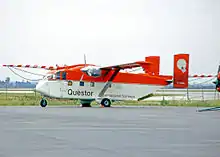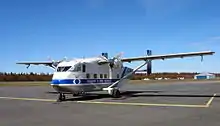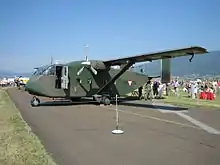Short SC.7 Skyvan
The Short SC.7 Skyvan (nicknamed the "Flying Shoebox")[1] is a British 19-seat twin-turboprop aircraft manufactured by Short Brothers of Belfast, Northern Ireland. It is used mainly for short-haul freight and skydiving.
| SC.7 Skyvan | |
|---|---|
_arrives_at_RIAT_Fairford_12July2018_arp.jpg.webp) | |
| Skyvan at RAF Fairford, England, 2018 | |
| Role | Utility aircraft |
| National origin | United Kingdom |
| Manufacturer | Short Brothers |
| First flight | 17 January 1963 |
| Status | In limited service |
| Produced | 1963-1986 |
| Number built | 149 |
| Developed into | Short 330 Short 360 |
The Short 330 and Short 360 are stretched models of the original SC.7, designed as regional airliners.
Design and development
In 1958, Short was approached by F.G. Miles Ltd (successor company to Miles Aircraft) which was seeking backing to produce a development of the H.D.M.106 Caravan design with a high aspect ratio wing similar to that of the Hurel-Dubois HD.31. Short acquired the design and data gathered from trials of the Miles Aerovan based H.D.M.105 prototype. After evaluating the Miles proposal, Short rejected the Caravan.[2] They developed their own design for a utility all-metal aircraft which was called the Short SC.7 Skyvan. The Skyvan is a twin-engined all-metal, high-wing monoplane, with a braced, high aspect ratio wing, and an unpressurised, square-section fuselage with twin fins and rudders.[3] It was popular with freight operators compared to other small aircraft because of its large rear door for loading and unloading freight. Its fuselage resembles the shape of a railroad boxcar for simplicity and efficiency.

Construction started at Sydenham Airport in 1960, and the first prototype first flew on 17 January 1963, powered by two Continental piston engines.[4] Later in 1963, the prototype was re-engined with the intended Turbomeca Astazou II turboprop engines of 520 shp (390 kW);[5] the second prototype (the first Series 2 Skyvan) was initially fitted with Turbomeca Astazou X turboprop engines of 666 shp (497 kW) but subsequently the initial production version was powered by Turbomeca Astazou XII turboprop engines of 690 shp (510 kW). In 1967, it was found that the Astazou XII was temperature limited at high altitudes.[6] Consequently, in 1968, production switched to the Skyvan Series 3 aircraft, which replaced the Astazou engines with Garrett AiResearch TPE331 turboprops of 715 shp (533 kW). A total of 149 Skyvans (including the two prototypes)[7] were produced before production ended in 1986. The United States Air Force operated Sherpa Skyvans in Europe for spare parts and cargo delivery. The larger Sherpas were developed from the earlier models.
Operational history
Skyvans served widely in both military and civilian operations, and the type remained in service in 2009 with a number of civilian operators, and in military service in Guyana and Oman.

Skyvans continue to be used in limited numbers for air-to-air photography and for skydiving operations. In 1970, Questor Surveys of Toronto Canada converted the first of two Skyvan 3s for aerial geological survey work. The Collier Mosquito Control District uses Skyvans for aerial spraying.[8]
Argentina
The Argentine Naval Prefecture purchased five Skyvans in 1971, which they gave the call signs PA-50 to PA-54.
During the 1982 Falklands War the aircraft were assigned to conduct search and reconnaissance, rescue and transport duties. PA-50 arrived at BAN Río Grande on 15 April 1982 and was joined by PA-54 arrived on 17 April 1982.[9] PA-54 was subsequently deployed to Stanley/EAN Malvinas on 20 April 1982 and was joined on the Falklands by PA-50 on 30 April 1982, which was based at Pebble Island/EAN Calderón.[9] Meanwhile PA-51 was deployed to EAN Río Gallegos on 24 April 1982 and PA-52 to BAN Río Grande on 11 May 1982.[9] While waiting to be put into service PA-54 was damaged while sitting on the Stanley racecourse by British naval gunfire during on the evening of 3 May 1982. It did not fly again and was finally destroyed by shellfire during British bombardments on 12/13 June 1982. PA-50 saw some action at Pebble Island, but it ended up becoming bogged down in the soft ground, and on 15 May 1982 it was destroyed by a British raiding party.[10] At the conclusion of the war PA-51 and PA-52 returned to Aeroparque Jorge Newbery/Buenos Aires on 26 June 1982. The three remaining aircraft were eventually sold off by Argentine Naval Prefecture and by the early 2020’s, only PA-51 still existed.
During the depths of Argentina's Dirty War in 1977, around 4,400 detainees were taken on death flights and thrown to their deaths into the Río de la Plata.[11][12] By 2003, Italian photographer Giancarlo Ceraudo had become intrigued by the death flights and, with the assistance of the investigative journalist Miriam Lewin, began looking for the aircraft that had been used.[13] Lewin was a survivor of the Navy School of Mechanics (ESMA), which was one of the dictatorship’s most notorious detention, torture and extermination centres. They believed that Skyvans were among the aircraft that had participated in the death flights. In 2010 Ceraudo and Lewin eventually tracked down PA-51 to Fort Lauderdale, Florida, where it was owned by GB Airlink, whose then owner allowed a Miami based Argentinian sports journalist acting on their behalf to visit the aircraft and also provided all its flight logs, among which was one covering the period of the death flights.[13] A three-hour flight entry on 14 December 1977 led to the identification and 2017 conviction of pilots, Mario Daniel Arrú and Alejando Domingo D’Agostino for the murder of eight women and four men.[13] A third crew member Enrique José de Saint Georges, was charged but died of natural causes while awaiting trial.[13] The victims had been tortured, sedated prior to being loaded on the aircraft and their clothing was removed by members of the crew. In the air the Skyvan’s ramp door was opened and the captives were pushed out to fall thousands of feet to their death in the South Atlantic.[13][14]
Meanwhile GB Airlink had sold PA-51 to Win Aviation, headquartered in DeKalb, Illinois. In early 2023 it was announced that the company’s owner, Andri Wiese, had agreed to allow it to be purchased by the Argentinean Economy Ministry. The plane was flown back to Argentina[13] and plans are in being made for its display at the Espacio Memoria y Derechos Humanos in Buenos Aires.[14]
Variants
- Skyvan 1
- prototype, one built. 2 x Continental GTSIO-520 engines.
- Skyvan 1A
- re-engined 1st prototype. 2 x 388 kW (520 hp) Turbomeca Astazou II engines.
- Skyvan 2
- Turbomeca Astazou powered production. 8 Series 2 produced (including the second prototype).
- Skyvan 3
- Garrett TPE331 powered production. 140 produced (of all Series 3 versions) plus 2 Series 2 were converted.[15]
- Skyvan 3A
- higher gross weight version of Skyvan Series 3.

- Skyvan 3M
- military transport version. It can be used for supply dropping, assault transport, dropping paratroops, troop transport, cargo transport, casualty evacuation, plus search and rescue missions.
- Skyvan 3M-200
- high gross weight version of Skyvan 3M (MTOW 6,804 kg, 15,000 lb).
- Skyliner
- deluxe all-passenger version.
- Seavan
- Maritime patrol version, (SC7-3M-4022), principally used by the Sultan of Oman's Air Force / Royal Air Force of Oman (SOAF / RAFO)
Operators
Civilian operators
As of July 2009, a total of 39 Skyvan aircraft remained in airline or skydiving service, with Pink Aviation Services (4), Sonair (1), Swala Aviation (2), Transway Air Services (1), Deraya Air Taxi (3), Layang Layang Aerospace (1), Macair Airlines (1), Malaysia Air Charter (1), Olympic Airways (1), Pan Malaysian Air Transport (1), Wirakris Udara (1), CAE Aviation (1), Deltacraft (1), Invicta Aviation (2), Advanced Air (1), Allwest Freight (2), Era Alaska (3), GB Airlink (1), North Star Air Cargo (5), Skylift Taxi Aereo (1), Skydive Arizona (13), Skydive DeLand (1), Skydive Perris (5), Sydney Skydivers (2), SkyForce Piotrków Trybunalski (1), Skydive Pennsylvania and Summit Air (2), Eagle Air (2),[16] Sustut Air (1),[17] Ryan Air Services,[18] Nomad Air (2), Aalto University (Helsinki, Finland), Skykef (Israel)
As of January 2019 Era Alaska, Ryan Air Services and All West Freight no longer operate Skyvans.
Sydney skydivers no longer own Skyvans.
As of May 2019, Olympic Air (successor to Olympic Airways) no longer operates Skyvans.
In 2019, Invicta Aviation sold their 2 Skyvans (G-PIGY, G-BEOL) to the Guyana Defence Force.
Military operators
- Royal Air Force of Oman: Oman continues to operate five of its original 16 Skyvans as of December 2013.[20][21]
Former military operators
- Argentine Coast Guard: Bought five in 1971, survivors sold in 1995 following replacement by five CASA C-212 Aviocars.

- Malawi Police Force Air Wing
- Mauritania Islamic Air Force: bought two Skyvan 3Ms in 1975[24]
- Yemen Arab Republic Air Force: operated two Skyvans as of 1984[25]
- Republic of Singapore Air Force
- 121 Squadron, Republic of Singapore Air Force operated the Skyvan 3M for Utility transport and Search-and-locate duties from 1973 to 1993.
Specification (Skyvan 3)
Data from Jane's Civil and Military Upgrades 1994-95[26]
General characteristics
- Crew: 1–2
- Capacity: 19 passengers
- Length: 12.21 m (40 ft 1 in)
- Wingspan: 19.79 m (64 ft 11 in)
- Height: 4.60 m (15 ft 1 in)
- Wing area: 35.12 m2 (378.0 sq ft)
- Empty weight: 3,331 kg (7,344 lb)
- Max takeoff weight: 5,670 kg (12,500 lb)
- Fuel capacity: 1,109 L (244 imp gal; 293 US gal)
- Powerplant: 2 × Garrett AiResearch TPE-331-2-201A turboprops, 533 kW (715 shp) each
- Propellers: 3-bladed Hartzell HC-B3TN-5/T10282H variable-pitch propeller
Performance
- Maximum speed: 324 km/h (201 mph, 175 kn) max cruise at 3,050 m (10,010 ft)
- Cruise speed: 278 km/h (173 mph, 150 kn) econ cruise at 3,050 m (10,010 ft)
- Stall speed: 111 km/h (69 mph, 60 kn) flaps down, EAS
- Never exceed speed: 402 km/h (250 mph, 217 kn) EAS
- Range: 1,115 km (693 mi, 602 nmi)
- Service ceiling: 6,858 m (22,500 ft)
- Rate of climb: 8.3 m/s (1,640 ft/min)
- Takeoff run to 15 m (50 ft): 482 m (1,581 ft) (STOL)
- Landing run from 15 m (50 ft): 567 m (1,860 ft) (STOL)
See also
Related development
Aircraft of comparable role, configuration, and era
- Antonov An-28
- CASA C-212 Aviocar
- De Havilland Canada DHC-6 Twin Otter
- Dornier 228
- GAF Nomad
- Harbin Y-12
- IAI Arava
- LET L-410
- PZL M28
Related lists
References
Citations
- "Your Place And Mine - Topics - Transport - The Flying Shoebox - The Shorts Skyvan". Archived from the original on 20 August 2004.
- Barnes 1989, pp. 477–478
- Barnes 1989, pp. 478–481
- Barnes 1989, p. 481
- Barnes 1989, p. 482
- Barnes 1989, pp. 486–487
- Barnes 1989, pp. 531–533
- "Collier Mosquito Control District 2019 Open House".
- Klaus, Erich (15 December 2009). "Argentina: Prefectura Naval Argentina". Aeroflight. Retrieved 24 March 2023.
- Burden, Rodney et al. Falkland: The Air War. London: Arms and Armour, 1986. ISBN 0-85368-842-7.
- Goñi, Uki (29 November 2017). "Argentina 'death flight' pilots sentenced for deaths including pope's friend". The Guardian. Retrieved 25 March 2023.
- "Unas 4.400 personas fueron eliminadas con los vuelos de la Muerte". La Razón (in Spanish). 19 January 2005.
- Goñi, Uki (24 March 2023). "'No one can deny it now': death flight plane to be returned to Argentina". The Guardian. Retrieved 25 March 2023.
- Mango, Agustín (24 March 2023). "The final voyage of Argentina's "death flights"". Buenos Aires Herald. Retrieved 26 March 2023.
- Barnes 1989 p488.
- Flight International, 3–9 October 2006
- "Short SC.7 Skyvan." Archived 24 January 2010 at the Wayback Machine sustutair.com. Retrieved: 8 January 2012.
- "Short SC.7 Skyvan". texrus.com. Archived from the original on 20 December 2010. Retrieved 8 January 2012.
- Hoyle 2013, p. 38
- Hoyle 2013, p. 43
- Taylor 1982, p. 271
- "Short SC.7 SRS 3M "Skyvan"" (in German). Archived from the original on 16 March 2016. Retrieved 18 October 2015.
- "Ghana Air Force". Archived from the original on 25 May 2009. Retrieved 17 December 2012.
- Cooper, Tom; Grandolini, Albert (2018). Showdown in Western Sahara, Volume 1: Air Warfare Over the Last African Colony, 1945-1975. Warwick, UK: Helion & Company Publishing. p. 47. ISBN 978-1-912390-35-9.
- Cooper, Tom (2017). Hot Skies Over Yemen, Volume 1: Aerial Warfare Over the South Arabian Peninsula, 1962-1994. Solihull, UK: Helion & Company Publishing. p. 42. ISBN 978-1-912174-23-2.
- Michell 1994, pp. 228–229
Bibliography
- Barnes, C. H.; James, Derek N. (1990). Shorts Aircraft since 1900. London: Putnam. ISBN 0-85177-819-4.
- Hoyle, Craig (13–19 December 2011). "World Air Forces Directory". Flight International. pp. 26–52. ISSN 0015-3710.
- Hoyle, Craig (10–16 December 2013). "World Air Forces Directory". Flight International. Vol. 184, no. 5419. pp. 24–51. ISSN 0015-3710.
- Jackson, A. J. (1974). British Civil Aircraft Since 1919 (2nd ed.). London: Putnam. ISBN 0-370-10014-X.
- Michell, Simon, ed. (1994). Jane's Civil and Military Upgrades 1994-95 (Second ed.). London: Jane's Information Group. ISBN 0-7106-1208-7.
- Taylor, John W. R., ed. (1982). Jane's All the World's Aircraft 1982–83. London: Jane's Yearbooks. ISBN 0-7106-0748-2.
External links
 Media related to Short Skyvan at Wikimedia Commons
Media related to Short Skyvan at Wikimedia Commons